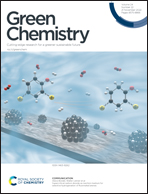Targeted H2O activation to manipulate the selective photocatalytic reduction of CO2 to CH3OH over carbon nitride-supported cobalt sulfide†
Abstract
The selective photocatalytic reduction of CO2 by H2O to methanol is a desirable solution for solar energy storage with the production of abundant chemicals. However, this is a formidable challenge because the conversion of CO2 to CH3OH is a 6-electron transfer reaction that needs 4 protons, while other products requiring less electrons and protons, such as CO, HCOOH, and HCHO, are much easier to form than CH3OH, leading to lower selectivity for the production CH3OH. Herein, we propose a novel concept of targeting activated H2O to provide ample protons without the generation of strong oxidative free radicals for the highly selective photocatalytic reduction of CO2 to CH3OH with H2O. Carbon nitride (CN)-supported cobalt sulfide (CS) was fabricated as the desired prototype photocatalyst (CS/CN). Cobalt sulfide was confirmed to promote the generation of protons without the formation of strong oxidative free radicals (such as ˙OH and ˙O2−) by significantly weakening the overpotential of the H2O oxidation half-reaction. This targeted H2O activation contributed to the continuous coupling of multi-protons/electrons and CO2 to form the key intermediates CHO* and CH3O*, which were necessary for the generation of CH3OH. Accordingly, the CH3OH selectivity by the optimized CS/CN (87.2%) photocatalyst was 2.3 times higher than that of CN (38.6%) with an increase in the CH3OH production rate from 22.0 μmol g−1 h−1 to 97.3 μmol g−1 h−1. This work provides an elegant solution to achieve the highly selective photocatalytic conversion of CO2 to CH3OH by modulating the H2O activation process.



 Please wait while we load your content...
Please wait while we load your content...